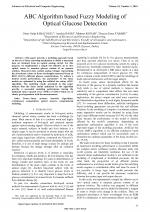| 3/2016 - 6 |
ABC Algorithm based Fuzzy Modeling of Optical Glucose DetectionSARACOGLU, O. G. |
| Extra paper information in |
| Click to see author's profile in |
| Download PDF |
Author keywords
fuzzy systems, heuristic algorithms, evolutionary computation, optical sensors, computational modeling
References keywords
fuzzy(21), glucose(13), systems(12), biosensors(9), algorithm(9), measurement(8), modeling(7), control(7), vivo(6), system(5)
Blue keywords are present in both the references section and the paper title.
About this article
Date of Publication: 2016-08-31
Volume 16, Issue 3, Year 2016, On page(s): 37 - 42
ISSN: 1582-7445, e-ISSN: 1844-7600
Digital Object Identifier: 10.4316/AECE.2016.03006
Web of Science Accession Number: 000384750000006
SCOPUS ID: 84991111440
Abstract
This paper presents a modeling approach based on the use of fuzzy reasoning mechanism to define a measured data set obtained from an optical sensing circuit. For this purpose, we implemented a simple but effective an in vitro optical sensor to measure glucose content of an aqueous solution. Measured data contain analog voltages representing the absorbance values of three wavelengths measured from an RGB LED in different glucose concentrations. To achieve a desired model performance, the parameters of the fuzzy models are optimized by using the artificial bee colony (ABC) algorithm. The modeling results presented in this paper indicate that the fuzzy model optimized by the algorithm provide a successful modeling performance having the minimum mean squared error (MSE) of 0.0013 which are in clearly good agreement with the measurements. |
| References | | | Cited By |
Web of Science® Times Cited: 4 [View]
View record in Web of Science® [View]
View Related Records® [View]
Updated today
SCOPUS® Times Cited: 3
View record in SCOPUS® [Free preview]
View citations in SCOPUS® [Free preview]
[1] MİLİMETRE DALGA BANDINDA İNVAZİF OLMAYAN BİR YÖNTEM İLE SIVILARDA GLİKOZ SEVİYESİNİN BELİRLENMESİ, GÖKTAŞ, Ömer Faruk, ÇANKAYA, İlyas, ŞENGÜN ERMEYDAN, Esra, Uludağ University Journal of The Faculty of Engineering, ISSN 2148-4147, Issue 3, Volume 27, 2022.
Digital Object Identifier: 10.17482/uumfd.1125289 [CrossRef]
[2] Retracted: Improved artificial bee colony algorithm with opposition‐based learning, Cao, Yongcun, Ji, Saisai, Lu, Yong, IET Image Processing, ISSN 1751-9659, Issue 15, Volume 14, 2020.
Digital Object Identifier: 10.1049/iet-ipr.2020.0111 [CrossRef]
Disclaimer: All information displayed above was retrieved by using remote connections to respective databases. For the best user experience, we update all data by using background processes, and use caches in order to reduce the load on the servers we retrieve the information from. As we have no control on the availability of the database servers and sometimes the Internet connectivity may be affected, we do not guarantee the information is correct or complete. For the most accurate data, please always consult the database sites directly. Some external links require authentication or an institutional subscription.
Web of Science® is a registered trademark of Clarivate Analytics, Scopus® is a registered trademark of Elsevier B.V., other product names, company names, brand names, trademarks and logos are the property of their respective owners.
Faculty of Electrical Engineering and Computer Science
Stefan cel Mare University of Suceava, Romania
All rights reserved: Advances in Electrical and Computer Engineering is a registered trademark of the Stefan cel Mare University of Suceava. No part of this publication may be reproduced, stored in a retrieval system, photocopied, recorded or archived, without the written permission from the Editor. When authors submit their papers for publication, they agree that the copyright for their article be transferred to the Faculty of Electrical Engineering and Computer Science, Stefan cel Mare University of Suceava, Romania, if and only if the articles are accepted for publication. The copyright covers the exclusive rights to reproduce and distribute the article, including reprints and translations.
Permission for other use: The copyright owner's consent does not extend to copying for general distribution, for promotion, for creating new works, or for resale. Specific written permission must be obtained from the Editor for such copying. Direct linking to files hosted on this website is strictly prohibited.
Disclaimer: Whilst every effort is made by the publishers and editorial board to see that no inaccurate or misleading data, opinions or statements appear in this journal, they wish to make it clear that all information and opinions formulated in the articles, as well as linguistic accuracy, are the sole responsibility of the author.



